|
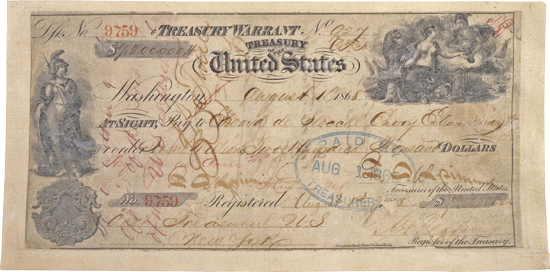
Cancelled Check for $7.2 million for the Purchase of
Alaska
Issued August 1, 1868 / National
Archives
Alaska Purchase 1867
With the Treaty of Cession
on March 30, 1867, the United States purchased Alaska from Russia
for USD 7.2 million. That was less than 2 cents per acre and hence a
bargain. (In today's money around 36 cents per acre, still a
bargain.)
Although a bargain, many Americans
didn't like the deal.
|
|
On October 18,
1867, Alaska officially changed hands with the
exchange of the ratified treaty at Sitka.
Interestingly, the payment was not made until a year
later. |
How Big
Is Alaska?
Enormous. 586,412 square miles
or 1,518,800 square km, that's more than twice the size of
Texas with 268,596 square miles or 695,662 square kilometers.
Someone at the Alaska State
Department of Commerce site made this little pic to illustrate
Alaska's massive size:
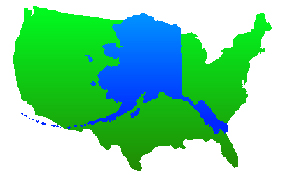
The US Department of Indian
Affairs brings it home:
The
Alaska Region encompasses 663,268 square
miles of land, an area that would stretch
from Atlanta, Georgia in the east to San
Francisco, California in the west and to
Minneapolis, Minnesota in the north. Within
Alaska are a dynamic and diverse mix of
Tribes...
Why Did
Russia Sell Alaska?
It really doesn't make any sense when
we think about it today, but at the time, the fact that Russia had
just lost the
 Crimean War (1853-1856) must have
played a role. (The first Russian offer was made shortly after the
war, in
1859, for $5.6 million.)
Crimean War (1853-1856) must have
played a role. (The first Russian offer was made shortly after the
war, in
1859, for $5.6 million.)
The rational there might have been
that Alaska was too hard to defend against the British in any future
war. Might as well make a buck selling it.
But the deal didn't go through. Russia
wasn't ready to sell, the U.S. not ready to buy.
Alaska was unexplored and only very lightly populated. The Office of
the Historian tells us that St. Petersburg,
...
lacked the financial resources to support
major settlements or a military presence
along the Pacific coast of North America and
permanent Russian settlers in Alaska never
numbered more than four hundred.
And it was still 30 years before the
 Klondike / Yukon gold rush
would bring new appreciation to the area.
Klondike / Yukon gold rush
would bring new appreciation to the area.
All in all, the Russians saw Alaska more as a burden than anything else.
And the Americans kind of agreed.
Who Negotiated the Alaska
Purchase?
For the U.S., under
 President
Andrew Johnson, the U.S. Secretary of State,
William H. Seward.
President
Andrew Johnson, the U.S. Secretary of State,
William H. Seward.
For Russia, under
 Tsar Alexander II,
the Russian Privy Councillor, Edward (or Edouard,
or Eduard) de Stoeckl.
Tsar Alexander II,
the Russian Privy Councillor, Edward (or Edouard,
or Eduard) de Stoeckl.
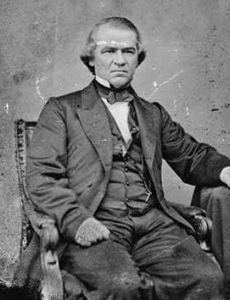 |
|
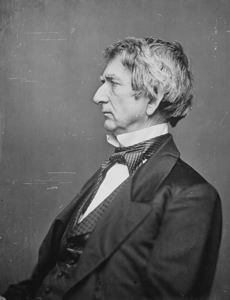 |
Andrew Johnson
17th
President of the United States (1865-1869)
U.S. National Park Service |
|
William H. Seward
U.S. Secretary of
State
(1861-1869)
National Archives |
| |
|
|
 |
|
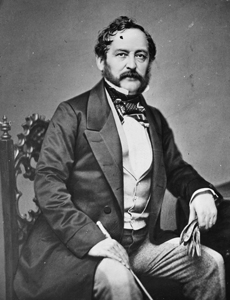 |
|
Alexander II
Emperor of Russia
(185581)
Library of Congress |
|
Baron Eduard de Stoeckl
Russian
minister to
the United States
Library of Congress |
Seward's Folly . . .
Not So Folly After All
You would think a bargain such as this
would prompt everyone in the U.S. to thank Mr Seward
abundantly, but no. Americans more or less agreed with the Russians, this
was a wasteland, and therefore a total waste of money.
Some doubters termed this
purchase "Seward's Folly." And it was freezing. So it
became "Seward's Icebox" and "Johnson's Polar Bear Garden."
Yes it was true, with this deal, Russia would
completely withdraw from North America, but even so, U.S.
congressmen still had to be bribed by the Russian emissary to vote
in favor of the purchase of Alaska.
It took the discovery of gold in the Yukon in 1896
(see map below), and the
strategic positioning during
 World War 2, to convince.
World War 2, to convince.
Alaska Purchase and the Natives
Article III of the Treaty states as
follows,
The inhabitants of the ceded territory, according to their choice,
reserving their natural allegiance, may return to Russia within
three years; but if they should prefer to remain in the ceded
territory, they, with the exception of uncivilized native tribes,
shall be admitted to the enjoyment of all the rights, advantages,
and immunities of citizens of the United States, and shall be
maintained and protected in the free enjoyment of their liberty,
property, and religion.
The uncivilized tribes will be subject to
such laws and regulations as the United States may, from time to
time, adopt in regard to aboriginal tribes of that country.
That's right. The owners of most of
the land in question weren't consulted with regards to its sale.
Moreover, they had to stomach this Article 3.
By the way, these are the Alaska
Native Tribes and their home regions
Inpuiat
Arctic Slope, NANA, and Bering Straits
regions
Yupik Calista, Bristol Bay, and Bering
Straits regions
Tlingit, Tsimshian, and Haida Sealaska
region
Athabascan Cook Inlet, Doyon and Ahtna
regions
Aleut Aleut region
Alutiiq Koniag, Bristol Bay, Chugach and
Cook Inlet regions
Eyak Chugach region
And here is the
 Working Effectively with Alaska Native Tribes
and Organizations Desk Guide (PDF). This desk guide
was created for BLM employees and adapted for USFWS employees.
Working Effectively with Alaska Native Tribes
and Organizations Desk Guide (PDF). This desk guide
was created for BLM employees and adapted for USFWS employees.
And here are the maps:

Alaska - Native Villages 2016
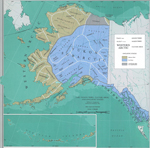
Alaska -
Early Indian Tribes
Timeline of the Alaska
Purchase
|
1859 |
|
Russia signals their
willingness to sell Alaska, but the U.S. have more urgent business
to attend to, i.e. the Civil War (1861-1865). Still, it would be
nice to grab the land before
the Brits could get the opportunity. |
|
|
|
|
|
March
11, 1867 |
|
Stoeckl meets with Seward at
Washington and signals that he is
authorized to negotiate the sale of
Alaska.
Seward
has to talk to the President first. |
|
|
|
|
|
March
14, 1867 |
|
Stoeckl and Seward meet again.
Seward says he is interested, and
that he talked with President
Johnson, who was "not inclined"
toward the purchase but willing to
listen to Seward's advice. He needs to
talk to the cabinet members.
Stoeckl says he too will talk to his
friends in Congress.
Seward floats the idea of $5
million, or "perhaps $5.5 million,
but no more." Thus raising his own
bid.
This prompts Stoeckl to mention in a
telegram to Russia that he could get
at least $6 million, maybe even $6.5
million. |
|
|
|
|
|
March
15, 1867 |
|
Seward
has a draft treaty prepared for the
cabinet. He is asking to authorize
$7 million to buy Alaska.
The
cabinet couldn't care less, but
didn't disagree. President Johnson
doesn't even comment.
Seward tells Stoeckl he is
authorized to pay $6.5 million tops.
Stoeckl says $7 million, and it's a deal. |
|
|
|
|
|
March
25, 1867 |
|
Seward
asks Stoeckl to cable Russia pronto.
He wants the treaty signed before
the Senate adjourns. |
|
|
|
|
|
March
29, 1867 |
|
Stoeckl gets the ok from Russia.
That evening he visits Seward at his
private address on Lafayette Square
and tells him "Tomorrow, if you
like, I will come to the department,
and we can enter upon the treaty."
Seward replies, "Why wait until
tomorrow, Mr. Stoeckl? Let us make
the treaty tonight." |
| |
|
|
|
March
30, 1867 |
|
Treaty
of Cession, aka the Alaska Purchase between Russia and the
United States, agreed at Washington
 Transcript
Transcript
 Original Treaty
Original Treaty
 Original Treaty - Russian Version
Original Treaty - Russian Version |
| |
|
|
|
April
9, 1867 |
|
The
U.S. Senate approves the purchase,
voting 37 to 2. |
| |
|
|
|
May
28, 1867 |
|
U.S.
President Andrew Johnson signs the
treaty, ratifying this purchase. |
| |
|
|
|
October 18, 1867 |
|
With a
ceremonial exchange of ratifications
at Sitka, Alaska officially belongs
to the United States. Most Russians
will leave soon after. However, the money
still hasn't been paid. |
| |
|
|
|
July
14, 1868 |
|
The
House votes 113 to 43 to appropriate
the money for the Alaska purchase. |
| |
|
|
|
July
27, 1868 |
|
Act of
Congress "making an appropriation of
money to carry into effect the
treaty with Russia of March 30,
1867" |
| |
|
|
|
August 1, 1868 |
|
The U.S. issues the
check |
| |
|
|
|
August 15, 1868 |
|
Russia cashes the
check |
| |
|
|
|
1946 |
|
Alaskans vote in
favor of statehood with 9,630 to 6,822.
Congress will hesitate for a few
more years. |
| |
|
|
|
1955 / 1956 |
|
The
Constitutional
Convention convened November 8,
1955, and adjourned February 6,
1956. All this to speed up the slow
movings toward statehood.
On
February 5, 1956, the
constitution was formally adopted.
Still not a state yet, but
constitution in place.
On
April 24, 1956, the Alaskans ratify
their constitution. It will become
law on January
3, 1959.
 Here's Alaska's Constitution as PDF
Here's Alaska's Constitution as PDF |
| |
|
|
|
January 3, 1959 |
|
Under
 President
Eisenhower, Alaska
becomes the 49th state
President
Eisenhower, Alaska
becomes the 49th state |
Here is More on the
Gold Rush in Canada and Alaska
The National Park Service
provides us with this great map:
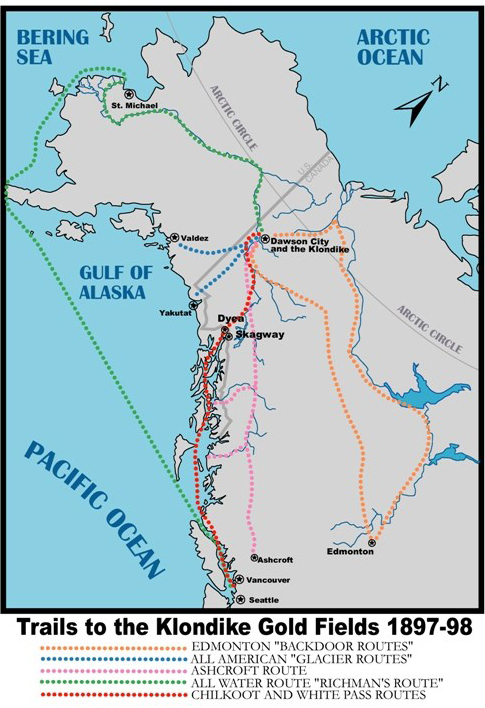
Map of the Trails to the Klondike Gold Fields
1897-98
illustrating:
Edmonton "Backdoor Routes"
All American "Glacier Routes"
Ashcroft Route
All Water Route "Richman's Route"
Chilkoot and White Pass Routes
National Park Service Map
Go here for the main
 Gold Rush in North America page
Gold Rush in North America page
And while we're
at it:
How close is
Alaska to Russia? Back in the Days
It used to be connected
via the Bering Land Bridge on which humans came to the
Americas in the first place.
How was the bridge formed?
Thanks to the ice age, water got locked up in glaciers, sea
levels dropped enormously, and land masses were exposed.
People packed their bags and were on their way.
Below we have a map of ancient Beringia 20,000 years ago,
aka the exiting land bridge across the Bering Sea, named
after
 Vitus Bering, the
Danish explorer who battled scurvy like all good explorers,
and who worked under Russia's
Vitus Bering, the
Danish explorer who battled scurvy like all good explorers,
and who worked under Russia's
 Tsar Peter I the Great
(who ordered the expedition), then Tsar
Peter II and
later
Tsar Peter I the Great
(who ordered the expedition), then Tsar
Peter II and
later
 Tsarina Anna Ivanova.
Tsarina Anna Ivanova.
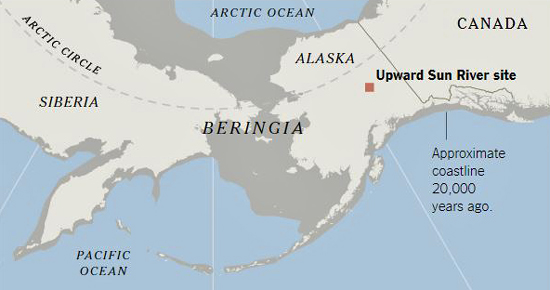
Map of Ancient
Beringia
Illustrating the Upward Sun River site,
discovered in 2006, the site of the discovery of the oldest known human
remains ever recovered from the Arctic/Subarctic of North America,
the
11,500 year old skeleton of an infant girl. Here is the
 NYT article.
NYT article.
New York Times Map / Sources: Moreno-Mayar et al. Nature:
Science
See also this map:

Ancient Beringia
And more here:
 About Ancient Beringia
About Ancient Beringia
How close is
Alaska to Russia? Today
Fifty-five miles, but it freezes
over when it's Winter!

This from the Alaska Public
Land Information Centers:
The narrowest distance between mainland Russia and mainland
Alaska is approximately 55 miles.
However, in the body of
water between Alaska and Russia, known as the Bering Strait,
there lies two small islands known as Big Diomede and Little
Diomede.
Interestingly enough, Big Diomede is owned by
Russia while Little Diomede is owned by the US.
The stretch
of water between these two islands is only about 2.5 miles
wide and actually freezes over during the winter so you
could technically walk from the US to Russia on this
seasonal sea ice.
By the way, apparently she never
said,
 I can see Russia from my house.
I can see Russia from my house.
More Maps
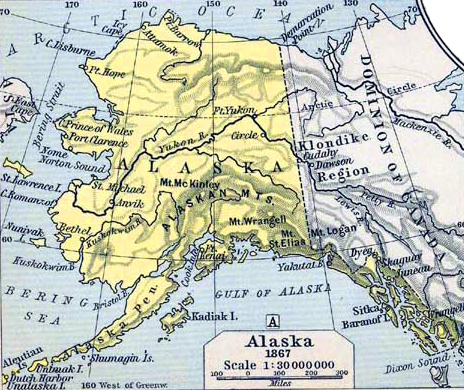
Map of Alaska
From
 Territorial Expansion of the United States since 1803
Territorial Expansion of the United States since 1803
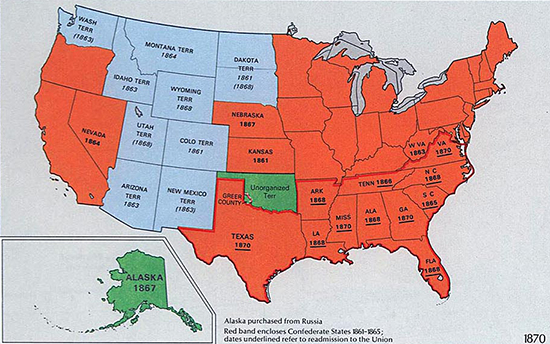
Territorial Expansion
of the United States: Situation in 1870
From
 Fourteen history maps of the United States: Territorial Growth
1775-1970
Fourteen history maps of the United States: Territorial Growth
1775-1970
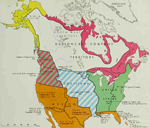
1670-1867 North
America: Territorial Possessions
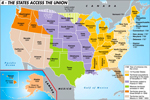
1787 The
States Access the Union

United States
1689 - 1945 Battle Sites
See more from the National
Archives:
 Seward's Bargain: The Alaska Purchase
from Russia
Seward's Bargain: The Alaska Purchase
from Russia
More History
|